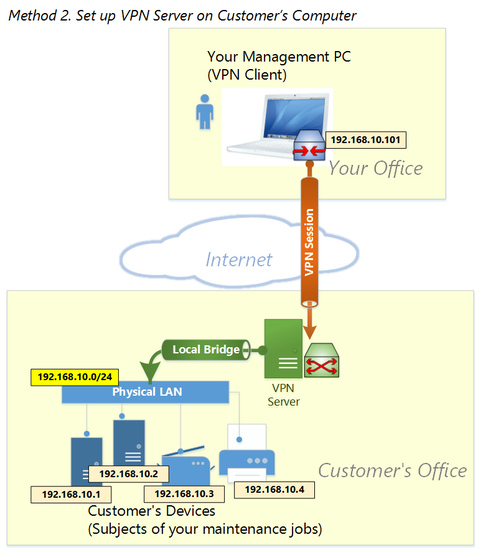
Principles
In order to reduce your costs and gain the comfortable daily business, use SoftEther VPN. You can install SoftEther VPN Client or SoftEther VPN Bridge on each location which you have to support as your business. SoftEther VPN Client and SoftEther VPN Bridge keeps VPN tunnels to your SoftEther VPN Server in your office, even if Clients or Bridges are behind firewalls.
Then you can access to any devices of customer-side networks from your desk. No more need to make business trips for maintenance or troubleshooting.
Method 1. Set up VPN Clients on Customer's Computers
You can install SoftEther VPN Client on customer's computer which you are supporting. Before that, you have to install SoftEther VPN Server on your company. After that, you can configure the customer-side SoftEther VPN Client to keep a VPN tunnel 24h/365d to your VPN Server. Then you can access to the computer remotely from your desk anytime.
Method 2. Set up VPN Server on Customer's Computer
You can set up a Local Bridge between the Virtual Hub and the physical Ethernet segment on customer's computer. Then you can access to the customer's network remotely from your desk anytime.
Method 3. Set up VPN Bridge on Customer's Computer
When you visit to customer's network physically, set up SoftEther VPN Bridge on one of customer's computers. Define a Local Bridge on the VPN Bridge, and make a Cascade Connection link to a Virtual Hub on your company's SoftEther VPN Server. After that, the Cascade Connection will be kept 24h/365d. If you have two or more customers repeat this step for each customer.
Then your company's SoftEther VPN Server has several Virtual Hubs for each customer. You can connect to a specific Virtual Hub from your PC with SoftEther VPN Client. When you are connected to a specific Virtual Hub, you are now joined to the remote customer's network, and you can communicate with any computers on customer's network.
This method is called as "reverse-connection" , because the direction of VPN connection is "from the customer-side" despite the customer-side network is the destination. This reverse-connection technique is useful especially with customer's troublesome firewall. Usually such firewalls block inbound connection from the Internet so you must obtain special permission from customer's network administrators. However by exploiting the reverse-connection technique you can omit that process, and you can directly connect into customer's network from outside, without network administrator's permission.
Method 4. Use VPN Azure
With VPN Azure, the cloud-based VPN tunneling relay servers which are operated by SoftEther Project can relay VPN tunnels. It can penetrate customer's restricted firewalls without any modifications. VPN Azure is the easiest way to penetrate firewalls, and to reach the SoftEther VPN Server behind the firewall.




